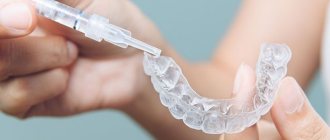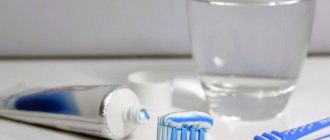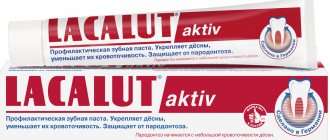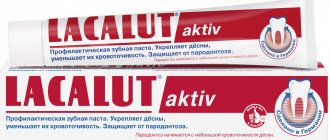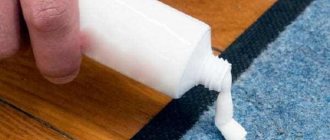No dentist will give a definite answer to the question of which toothpaste you should choose for regular teeth cleaning.
The huge range of toothpastes on the modern market leaves the right of choice to the patient, since the effectiveness of the paste can only be determined after personal experience of using it.
The doctor can only explain which series of products should be used to brush teeth in a particular situation, based on the patient’s oral problems.
Properties of toothpastes
A good toothpaste should have certain properties, namely:
- have a pleasant taste and smell;
- produce a high refreshing effect;
- prevent the formation of plaque on teeth;
- be homogeneous;
- do not dry out or delaminate during storage;
- have an anti-caries effect;
- do not cause allergic reactions, be harmless to the body;
- correspond to the effect stated on the label after use;
- For complete teeth cleaning, a strip of paste 0.5-1 cm long should be enough.
To choose the right toothpaste, you need to carefully study its purpose and composition, since different products are used for different problems of the oral cavity.
Top 3. ROCS Pro Brackets & Ortho
Rating (2021): 4.64
290 reviews from resources were taken into account: Yandex.Market, Ozon, Wildberries, Otzovik, IRecommend
The best solution for wearing braces ROCS Pro Brackets & Ortho is designed specifically for those who wear braces or dentures. The paste has improved cleansing properties and can rightfully be considered the best in its category.
- Characteristics
Average price: 380 rub. (135 g)
- Active ingredients: bromelain, xylitol, calcium
- Properties: high-quality cleansing, protection against caries
ROCS Pro Brackets & Ortho is designed specifically to meet the needs of those who wear orthopedic or orthodontic structures in the mouth - braces, removable bite correction devices or dentures. The composition of the product helps to more effectively clean the mouth and dissolve plaque, even in places where it is impossible to reach with a toothbrush. The formula with enzymes and minerals helps protect teeth from caries and gums from inflammation. Reviews from those who have tried this product are only positive and confirm that its cleansing effect is truly excellent. The only drawback is the high price, but this paste can be forgiven given its high quality.
Advantages and disadvantages
- Specialized product for those who wear braces or dentures
- Improved formula for complete teeth cleaning
- Helps protect teeth from caries and gums from inflammation
- High price
See also:
- 10 Best Remedies for Bad Breath
What types of toothpastes are there?
Based on their effect on the oral cavity, pastes are divided into therapeutic, therapeutic and prophylactic and prophylactic. Belonging to one or another group is indicated on the front side of the package, so determining the purpose of the paste at the time of purchase is not difficult.
Depending on the age orientation, pastes are divided into children's and adults. Children's products for small children have a special composition, since there are often cases of them being swallowed by children during cleaning, and the components of adult pastes are prohibited here. Manufacturers add the same substances to toothpastes for older children as to adult products, but in lower concentrations.
Answers to two frequently asked questions
I hope we have convinced you that a child needs to have his own pasta. But children grow up, and sooner or later you have to part with childhood. At what age should I switch to adult (general) toothpaste? Here it is necessary to take into account, on the one hand, the child’s skills and consciousness: if he carefully rinses his mouth every time, spits everything out and does not swallow anything, it means that he is already mentally ready. Another factor is the change of teeth. If most of the teeth are already molars, then the time to change the toothpaste has obviously come. In other words, the transition from children's toothpaste to adult toothpaste should occur no earlier than 6, but no later than 10 years. However, for older children it is best to use “junior” paste rather than real adult paste - such pastes are produced by a number of manufacturers.
The second question that is often asked is whether adults can brush their teeth with children's toothpastes? Of course, it is possible - after all, such toothpastes are harmless, but the benefits for teeth from such cleaning will not be very great. After all, the content of nutrients in children's pastes is lower. So it is better if at each age we use the most suitable paste for us. Don’t forget to contact your dentist once every six months for a preventive examination and immediately if you discover any problem in your mouth.
Make an appointment Do not self-medicate. Contact our specialists who will correctly diagnose and prescribe treatment.
Composition of toothpastes
There are standard components that are included in any paste, regardless of its purpose:
- Abrasives are chalk additives, silicon and calcium compounds. Abrasive components are responsible for the quality of cleansing enamel from plaque.
- Water, glycerin - maintain moisture and consistency of the paste.
- Xanthan gum is a stabilizer and thickener, also responsible for the consistency of the product.
- Foaming substances - depending on their amount, the paste foams more or less while brushing your teeth.
- Sorbitol or xylitol – give the paste a sweet taste. Sorbitol also serves as an emulsifier, and xylitol inhibits the development of cariogenic bacteria.
- Preservatives (sodium benzoate, parabens) – prevent the development of bacteria in an open tube, extend the shelf life of the paste. Should be used in limited quantities in products for children.
- Flavorings – peppermint oil is most often used.
Undesirable components that should be excluded from the composition, or their quantity should be reduced to a minimum, include:
- Polyethylene glycol (PEG) is harmful to the kidneys.
- Sodium lauryl sulfate - in large quantities has a negative effect on the mucous membranes of the mouth and stomach.
- Triclosan, chlorhexidine - have an antibacterial effect and are allowed only for medicinal pastes. With prolonged daily use of products containing these substances, the vital activity of the normal microflora of the oral cavity is disrupted.
Preventative toothpastes
Preventive toothpastes are also called hygienic; their purpose is daily oral care without therapeutic effects. They are used to cleanse and refresh the oral cavity, if there are no complaints about the condition of the teeth and gums.
The main components of these pastes are: chemically precipitated chalk, glycerin, water, flavorings, preservatives and thickeners. Fluoride and calcium are sometimes added to prophylactic products to prevent the development of caries.
Therapeutic and prophylactic agents This is the most extensive group of toothpastes; it is divided into several subgroups.
Organic products
Organic toothpastes are available for all ages. You can purchase the product for both children and adults. They contain only natural ingredients. According to user reviews, these products are able to cope with their functions just as effectively as their synthetic counterparts. Such products are absolutely safe for people of all ages. On sale you can find organic pastes based on medicinal plants. They relieve inflammation well, help speed up the healing process of wounds and are excellent at fighting bleeding gums.
Fluoride-containing pastes
Such pastes are enriched with fluoride in the form of sodium fluoride, aminofluoride or monofluorophosphate in various concentrations. The designation of fluoride concentration on the packaging can be seen as the abbreviation “ppm” (parts per million). For adults, this value should not be higher than 1500 ppm. Fluoride-containing toothpaste should not be swallowed, so it should not be used on children who cannot spit and rinse their mouths.
Fluoride is effective in preventing the development of caries, but it should only be used in areas where low fluoride levels in the water have been confirmed. Residents of areas with sufficient fluoride levels should not use fluoride toothpastes. If you neglect this rule, due to an excess of the element in the body, dental fluorosis will develop - a violation of the pigmentation and structure of tooth enamel.
Remineralizing pastes
The products are designed to strengthen the enamel by saturating it with calcium and phosphorus compounds. Typically, pastes contain calcium citrate and calcium glycerophosphate. To get the proper effect, you need to brush your teeth for at least three minutes.
In addition to toothpastes, remineralizing gels are used at home: they are applied to the teeth and left for the time specified in the instructions for the product.
The use of remineralizing agents is especially indicated for children from 6 years of age, during adolescence, when permanent teeth appear, intensive skeletal growth occurs and the need for calcium increases. Pastes are also recommended for pregnant women, as their tooth enamel often suffers from a lack of calcium.
Pastes with whitening effect
Many manufacturers of whitening toothpastes are disingenuous when they call them whitening; it would be more correct to call them “brightening” or “with an increased cleansing effect.” Lightening of enamel in pastes occurs by removing plaque and returning the natural color to the teeth. True enamel whitening can only be done in the dentist's office.
Removal of plaque using this group of products occurs due to increased abrasiveness; a tube of paste with a truly cleansing effect should contain information about the abrasiveness index. It is designated by the letters RDA; the higher the digital value of the index, the larger the grinding particles. RDA index values:
- 30-50 – non-abrasive paste, suitable for cleaning sensitive teeth;
- 50-80 – low abrasive, can be used by children over 14 years of age;
- 80-100 – moderately abrasive, used by adults daily;
- 100-200 – high abrasiveness of the paste, teeth are brushed 1-2 times a week, sometimes less often; It is advisable to consult a dentist before use.
The recommended abrasiveness for daily use is RDA 70-80, but you need to focus on the condition of your teeth and gums.
There are pastes in which the enamel is cleansed not through abrasive particles, but through the action of the enzymes papain and bromelain. Enzymes enter into a chemical reaction with plaque, gradually dissolving it.
If the packaging of a whitening toothpaste does not contain information about the RDA index or does not contain enzymes, it is unlikely that this product will be able to lighten tooth enamel.
Top 10. New Pearl Calcium
Rating (2021): 4.35
268 reviews from resources were taken into account: Yandex.Market, Wildberries, Otzovik, IRecommend
Best price New Pearl Calcium is the cheapest of the toothpastes presented in the rating. She failed to become the leader of the TOP, but she rightfully becomes the winner in the “Best Price” nomination.
- Characteristics
Average price: 43 rub. (100 g)
- Active Ingredients: Calcium
- Properties: cleansing, remineralization of enamel
New Pearl Calcium is a very budget toothpaste that is suitable for adults and children over three years of age. It can be used not only for brushing teeth, but also for applications aimed at strengthening enamel and reducing sensitivity. The product is quite popular and recognizable. Many dentists consider its quality to be quite decent and not inferior to foreign analogues in the same price category. The composition of the product is far from ideal. It contains preservatives, parabens, and SLS. For many regular customers, this circumstance is not a problem, especially considering the budget cost of the product.
Advantages and disadvantages
- Low price
- Suitable for the whole family
- Trusted by dentists
- Liquid, ends quickly
- Imperfect composition
Products for sensitive teeth
Pastes for sensitive teeth contain strontium chloride, potassium nitrate and sodium citrate - substances that block the sensitivity of nerve endings. A common component is hydroxyapatite; it is capable of creating a protective film on enamel. The pastes also contain extracts and oils of medicinal herbs, which have a beneficial effect on the condition of the gums.
Decreased tooth sensitivity develops a few days after starting to use the medicinal paste. But such products cannot be used for too long due to the fact that they do not have sufficient abrasiveness and do not remove plaque well. In addition, a constant decrease in tooth sensitivity leads to masking the symptoms of other diseases, such as caries.
At first, soft toothbrushes are used with toothpaste for sensitive teeth, but as soon as the painful sensations disappear, you need to return to a regular brush with medium bristles (medium hardness). If this is not done, plaque will begin to accumulate on the enamel.
After a treatment course with toothpaste for sensitive teeth, they switch to using remineralizing pastes.



